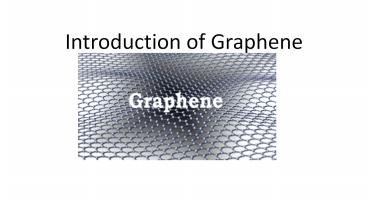Introduction of Graphene PowerPoint PPT Presentation
Title: Introduction of Graphene
1
Introduction of Graphene
2
What is graphene?
- The common graphite is formed by stacking a layer
of planar carbon atoms arranged in a honeycomb
order. The interlayer force of graphite is weak,
and it is easy to peel off to form a thin
graphite sheet. When the graphite sheet is peeled
off into a single layer, such a single layer
having a thickness of only one carbon atom is
graphene.
3
The first graphene
- The first graphene material was developed in 2004
by Professor Andrei Heim and his assistant,
Konstantin Novoselov. They separated the graphite
into smaller pieces, peeled off the thinner
graphite sheets from the pieces, and then taped
the sides of the sheets with plastic tape and
torn the tape. By repeated pasting and tearing, a
thinner and thinner graphite sheet is obtained
until it finally becomes a monoatomic layer of
graphene.
4
The structure of graphene
- Graphene is carbon material composed of carbon
atoms arranged in a hexagonal lattice neatly, and
its structure is very stable. The connection
between the carbon atoms of graphene is very
flexible, and when an external mechanical force
is applied, the carbon atom plane is bent and
deformed. In this way, the carbon atoms do not
need to be rearranged to accommodate the external
force, which ensures the stability of the
graphene structure, and makes the graphene harder
than the diamond, and can also be stretched like
a rubber. This stable lattice structure also
gives graphene excellent electrical conductivity.
When electrons in graphene move in orbit, they do
not scatter due to lattice defects or
introduction of foreign atoms.
5
Characteristics of graphene
- Graphene has proven to be the thinnest and
hardest substance ever found in the world. Its
thickness is only 0.335 nanometers, even if
200,000 films are stacked together, it is only as
thick as one hair. The single-layer graphene is
almost transparent, and its molecular arrangement
is tight, and even the smallest atomic size of
the crucible cannot pass. Another characteristic
of graphene is that its conductive electrons can
move unobstructed in the crystal lattice and the
speed is extremely fast, far exceeding the moving
speed of electrons move in metal conductors or
semiconductors. And the thermal conductivity of
graphene exceeds all known materials. The above
characteristics of graphene are very advantageous
for the development of ultra-thin flexible OLED
displays. It is said that Samsung's researchers
have produced transparent and flexible displays
made of materials such as multilayer graphene.
6
The applications of graphene
- In recent years, a series of advances have been
made in the research of new electronic materials
represented by graphene. Studies have shown that
graphene films have field emission
characteristics comparable to those of carbon
nanotube films, so they have a very broad
application prospect in semiconductor devices and
flat panel displays. Due to the unique
two-dimensional structure and excellent
crystallographic quality of graphene, it provides
an ideal platform for the study of quantum
electrodynamic phenomena and has important
theoretical research value. In addition, graphene
composited with plastic can be a conductor, and
its mechanical properties and heat resistance are
improved. The new material made of graphene and
plastic is lightweight and sturdy, and it can be
applied to a new generation of satellites,
aircraft and automobiles. Besides, graphene can
be used in high-sensitivity sensors and
high-performance energy storage devices. In
recent years, many scientific and
technical workers in various countries have made
many new advances in the research on the material
properties of graphene and the batch preparation
of graphene devices and materials.

